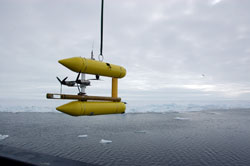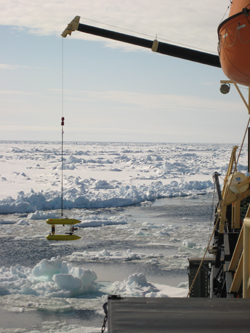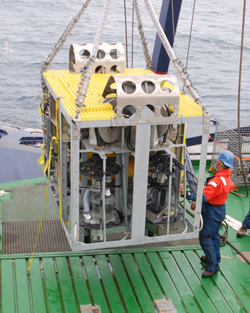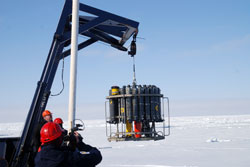Puma AUV Also known as the "plume mapper," the Puma autonomous underwater vehicle uses sonar, lasers, and chemical sensors to search wide areas near the ocean floor and detect the telltale temperature, chemical, or particulate signals from hydrothermal vent plumes. The AUV is part of a tag-team with Jaguar, with Puma being deployed first to conduct wide surveys, like a bloundhound finding a scent to find the source of mineral-rich, warm waters from the seafloor. Learn more about autonomous underwater vehicles >> Jaguar AUV The other half of the autonomous underwater vehicle tag team (with Puma), this robotic vehicle was designed to hover in place—like a helicopter or hummingbird—and collect photographs and high-resolution sonar maps of deep ocean vent sites. “Autonomous” vehicles are programmed aboard the ship and put into the water through a hole in the ice. They perform their missions with only minimal communication (using sound waves, or acoustics). Many hours later (10 to 24), they will have to find their way back to another hole in the ice and be recovered by the icebreaker. Learn more about oceanographic ships and technology >> CAMPER The CAMera samPlER, or "Camper" is a large sampling sled that will be towed by a research ship and lowered to the seafloor for collecting samples from the Arctic Ocean bottom. About the size of a sport utility vehicle, CAMPER is equipped with lights, a navigation system, chemical sensors, a video camera, and devices for quickly grabbing samples—a claw for grabbing hard samples such as rocks or clams, and a “slurp gun” that can vacuum in fluids or shrimp. The vehicle is positioned primarily by moving the ship, although the engineers can “drive” CAMPER in a small area using thrusters. The samples are of critical importance to biologists, who will use the DNA from the creatures they find to trace their origins. Learn more about towed underwater vehicles >> Learn more about remotely operated vehicles >> CTD CTD is an acronym for the parameters that this device measures: “Conductivity, Temperature, and Depth.” It uses a set of small probes to measure various water properties and cylindrical bottles for capturing samples of seawater. The CTD is lowered on a cable to the seafloor, and then slowly raised as it collects water at different depths. Scientists then analyze the water samples for their chemical properties, water temperature, and salt content, which tells physical oceanographers about the types of water masses present and how they are moving in the ocean. It is also important to the hydrothermal vent scientists on this cruise because the chemicals detected in the water will give scientists a rough idea of where vent plumes are. Only after the CTD has confirmed the existence of plume water will the autonomous underwater vehicles (AUVs) be deployed. Read more about CTDs >> Last updated: October 26, 2010 | ||||||||||||||||||||
Copyright ©2007 Woods Hole Oceanographic Institution, All Rights Reserved, Privacy Policy. | ||||||||||||||||||||




